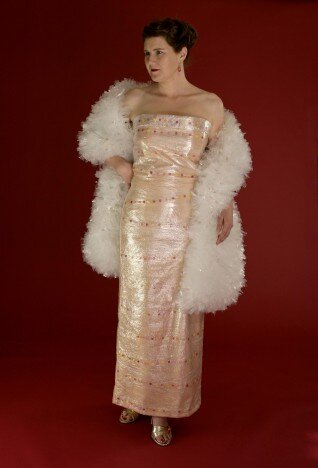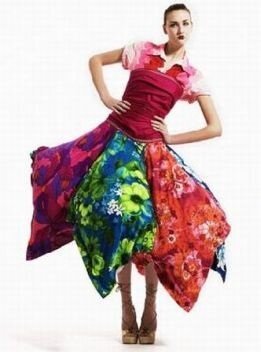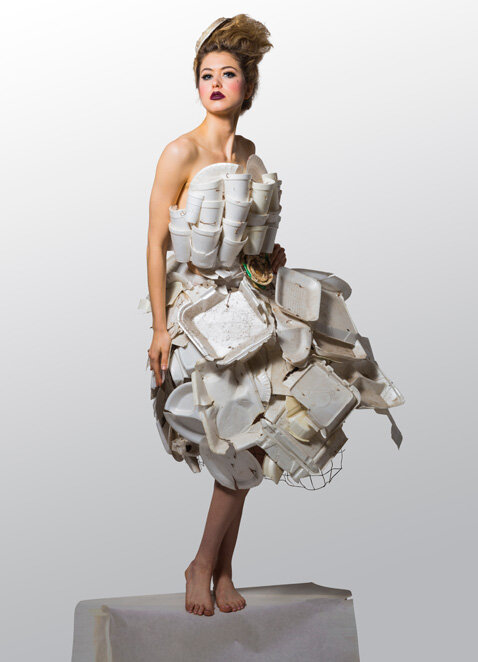
MOoW Spring Runway
MOoW Spring Runway features some favorite designers who have been steaming ahead of the fashion curve with colorful collections and wearable art. The mere shift to conscious use of fabric remnants and all manner of unlikely debris ironically opens up an explosion of playful, fresh ideas among forward-thinking designers, artists and other creative types. The fact that the clothes are most often individually assembled like works of art and skillfully hand-made guarantees that no two will be alike: each one an instant unique conscious classic.
Bethany Williams
This year, Bethany Williams became the second recipient of the Queen Elizabeth II Award for British Design which she deservedly won for her visionary talent and her strong commitment to social issues and sustainability. Her meteoric rise to stardom is grounded in an ethical mission to address some of the most pressing concerns of our day. She slyly redirects the obsessions of a fashion-addicted society to a thoroughly holistic approach to designing and making. She does is by collaborating with people from food banks, rehabilitation centers, and other charity services to reinvent fabric out of waste for her successful collections. Everything about Bethany Williams is inspiring and cutting edge.
© Bethany_Williams_London Instagram
Recycled plastic and dead stock yarn shirt and trousers, handwoven by @sanpatrignano residents of the rehabilitation program in Coriano, Italy
© Bethany_Williams_London Instagram
Recycled tent jacket and bag, prints designed by @giorgiachiarion
© Bethany_Williams_London Instagram
A hand knitted jumper using @woolandthegang biodegradable yarn and recycled tent trousers
© Bethany_Williams_London Instagram
A recycled tent jacket, screen printed in Peckham
© Bethany_Williams_London Instagram
Recycled @liverpoolecho newspaper jacket, hand-woven by @sanpatrignano and @helenkirkumstudio
Nancy Judd
Born and raised in Oregon, Nancy Judd is recognized worldwide for her art and environmental advocacy. Her “sculpture” takes the form of glamorous fashions which seductively broach the thorny subjects of resource use as well as the social impact of fashion. Her work has been featured on the front page of the Wall Street Journal and in Delta Airlines in-flight magazine among other news outlets and periodicals. Companies and organizations such as Delta Air Lines, Toyota, Coca-Cola, and Target have sponsored her sculptures and exhibitions. Her most high profile work, “The Obamanos Coat” is in the permanent collection of the Smithsonian Museum.
© Nancy Judd
Cassette Tape Jacket 2005: Cassette tape was woven onto the fabric of a second-hand coat to create the looped texture. The collar and cuffs are accented with the larger discarded video tape. A thrift store prom dress was cut up and sewn for the lining of the coat. This cold weather garment took 310 hours to create.
© Nancy Judd
The Environmental Stewardess 2011: Commissioned by Delta Airlines, this outfit is made entirely of worn out leather plane seat covers and safety flyers, The Purse was designed and made by Tierra Ideas.
© Nancy Judd
Detail The Environmental Stewardess 2011: cape made of Sky Magazines, old plane tickets and pretzel wrappers sewn onto old pillow cases, and lined with a discarded Delta blankets.
© Nancy Judd
Recycled plastic bottles spun into Eco-spun fabric transform into a shimmering evening gown covered in used plastic packaging film and accented with rings cut from post-consumer detergent bottles. The stole is knit from used clear plastic bags and lined with fabric from a second-hand white satin prom dress. The 2006 gown took 225 hours to create
© Nancy Judd
Sewn onto a used cloth shower curtain, hand-cut teardrops and circles from aluminum cans embellish both dress and shoes. This 2004 matching combo took 200 hours to create.
Vivan Sundaram
Born in Himachal Pradesh, India, in 1943, internationally celebrated multimedia artist Vivan Sundaram shifted his concentration in 1990 from painting to sculpture, installations, photography and video. Since 2009, Sundaram has been making sculptural garments with materials he attests “are all sourced from the dust bin.” The work here is all from a 2011 exhibition entitled “GAGAWAKA: Making Strange.” Sundaram comments that “there is a kind of Surrealism in the work.” The fashionista viewer cannot help but be amazed and amused by the panache and flair found in these sculptural garments that transform all manner of unlikely consumer trash into haute couture.
© Walsh Gallery Website
“Split Rubber” is made of rubber tires
©Wanqicdesma9 Website
“Shoeskin Hoop” is made of old leather shoes.
© Walsh Gallery Website
“Snake-shell” is made of discarded X-rays
Claudia Grau
Claudia Grau has been a creative force in Los Angeles for 30 years. In 1980, at the age of 21, she hung her shingle on Melrose Avenue in Hollywood, and became an instant success with stylists and celebrities. Grau was the first designer to use “green” reused, recycled clothing, and she continues to use it to this day. An early pioneer in deconstruction and collaged clothing, Grau still cuts up old cashmere garments, discarded men’s dress shirts, and vintage Japanese kimonos. All her designs are one-of-a-kind and handmade without the use of patterns.
© Claudia Grau
1980’s Japanese kimonos collaged into a one-of--kind piece
© Claudia Grau
A collage of 1980’s Japanese kimonos pieced into a colorful dress
Cut up cashmere sweaters from the Goodwill collaged into one-of-a-kind dresses.
© Claudia Grau
Men’s cotton dress shirts cut up and redesigned into cool cotton dresses, tops and tunics
Gary Harvey
London-based eco designer Gary Harvey’ is a visionary trend strategist, former Creative Director of Levi’s Europe, with a long list of prominent clients that include Adidas and Vivienne Westwood. His practice of using recycled materials began in his student days and he continues to invent new ways of manufacturing using discards of all sorts with inherent resonant associations. With humor and wit, he aims to recalibrate perceptions of all that is second-hand, overlooked and discarded, and to enlighten consumers about the social and environmental consequences of the fashion industry.
© Johanna Björk
The T-shirt dress delivers its message via tees donated by fellow activist and designer Katherine Hamnett who states: “People are the most powerful canvases – you can’t not read what’s written on a T-shirt, ” an opinion clearly shared by Harvey
© Gary Harvey Website
Couture ball gown made of cans, bottle tops, cardboard boxes (2014)
© TreeHugger Website
Baseball Puffball Dress made from 26 non-biodegradable nylon baseball jackets which were discarded at the end of the season; the socks made from the rib cuffs.
© Green Diary Website
Dress made out of seven recycled Aloha shirts (2007)
Marina DeBris
World-renowned American-born eco artist and sculptor Marina DeBris (a pseudonym) resides in Sidney, Australia. Her art and highly effective activism are devoted to raising awareness around the problem of ocean and beach pollution. Her medium is, of course, beach trash which she collects herself in situ. Besides being known for her art, curation, and fundraising, DeBris is also celebrated for her highly effective activism: working with nonprofits and involved in environmental public policy and education. She is listed with the Women Environmental Artists Directory, has been praised by EcoSalon as one of four important eco artists.
© Washedup Website
CRUSTACEA : Made entirely from trash found on a Los Angeles,CA beach or in the ocean.
© Stephen Wong
SUGAR COATED : Balls, stuffed animals & candy wrappers found washed up on a Los Angeles, CA beach
© Deepak Nath Gupta
GET WELL SOON : Everything was found washed up on a Los Angeles, CA beach.
© Richard Flynn
THE TAKEAWAY QUEEN : styrofoam found washed up on a Los Angeles beach.
© Stephen Wong
WASHED UP SALESMAN :Tags, pills, liquor bottles, swimming trunks & hat found washed up on a Los Angeles ,CA beach.
-Denise Domergue
Banner Image: Artist: Veronika Richterová
Photo by Michal Cihlář


























